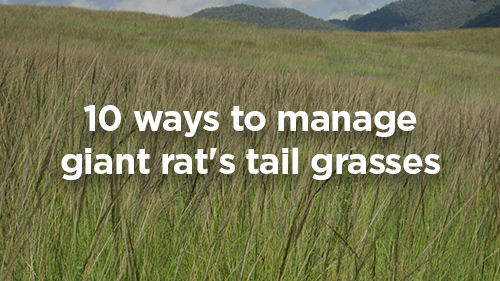23 September 2020.
 Giant rat’s tail grasses (GRT) are invasive grasses that can reduce pasture productivity, out-compete desirable pasture grasses and cause significant degradation of natural areas. They are often referred to as weedy Sporobolus grasses. GRT has low palatability when mature, difficult to control and can quickly dominate a pasture, especially following overgrazing or soil disturbance. Cattle health and productivity (including finishing times, weaning percentages and weights) can be affected.
Giant rat’s tail grasses (GRT) are invasive grasses that can reduce pasture productivity, out-compete desirable pasture grasses and cause significant degradation of natural areas. They are often referred to as weedy Sporobolus grasses. GRT has low palatability when mature, difficult to control and can quickly dominate a pasture, especially following overgrazing or soil disturbance. Cattle health and productivity (including finishing times, weaning percentages and weights) can be affected.
Four species of introduced Sporobolus grasses are invasive plants in Queensland. These are declared as Restricted Matter under the Biosecurity Act 2014. Everyone has an obligation to minimise risks of transporting, growing or spreading these rats tail grasses:
- giant rat’s tail grass (Sporobolus pyramidalis and Sporobolus natalensis)
- American rat’s tail grass (Sporobolus jacquemontii)
- giant Parramatta grass (Sporobolus fertilis).
Research underway
Biosecurity Queensland is helping improve our understanding and management through projects investigating:
- the effectiveness of residual, selective flupropanate herbicide in low and dense GRT infestations and if fertiliser applied after treatment improves pasture competition.
- the best combination of herbicide, application methods, competitive pastures and fertiliser to manage GRT.
- flupropanate run down in different soil types and the impact on GRT seedlings.
- biocontrol options using naturally occurring diseases and pests of GRT.
10 things you can do now to manage it
While there is still no silver bullet for GRT, here's how you can manage it:
- If you are not sure if you have GRT, send plant samples of suspected GRT grass to the Queensland Herbarium for positive identification. It can be difficult to pick introduced GRT species from native rat’s tail species, and nearly impossible to distinguish between the introduced GRT species.
- Control isolated plants and stop seeding. The cost of prevention is far less than ongoing costs of GRT control.
- Contain the spread of GRT by making 10 to 20 metre buffers along roadways, waterways and inside property boundaries. Always practice property, vehicle and equipment weed hygiene. Avoid moving through GRT areas when seeds are sticky, after rain or heavy dew. Only use reliable sources of fodder, pasture seed and equipment hire.
- Apply the correct calibrated dose of flupropanate for effective GRT control — 1.5 grams per square metre for granular and 2 millilitres per litre for liquid flupropanate. Too much will kill surrounding competitive pasture grass. Too little will not kill GRT tussocks. GRT mortality and residual effect depends on intensity and frequency of subsequent rainfall. Soil type and density of organic ground cover may also affect effectiveness of flupropanate.
- When spot spraying with glyphosate at a rate of 20ml per litre, trickle it down into the centre of the GRT tussock to prevent damaging nearby beneficial, competitive pasture grass. In open paddocks, wick wiping can selectively apply either or both herbicides to GRT with minimal damage to nearby beneficial pasture species. May require three or more wipes over 18 months.
- Abide by grazing withholding periods when applying herbicides. Fourteen days for spot spraying and four months for broadacre or aerially applied flupropanate. Slaughter withholding period is 14 days on clean feed after grazing in a flupropanate-treated paddock. Check herbicide label for withholding periods for lactating cows and goats. Glyphosate has no withholding period. Budget for ongoing GRT follow up for many years. The residual activity of flupropanate treated areas may last six months to two years, whereas GRT seed lives for more than eight years.
- Quarantine cattle for seven days to prevent the spread of GRT seed into clean areas.
- Promote pasture competition to control GRT. Pasture grasses and legumes with runners are more effective than tussock grasses in outcompeting GRT. Be aware of plant-back periods for certain improved pasture seeds after applying flupropanate herbicide.
- Heavy graze or slash when GRT plants are young and palatable, to reduce GRT plant size, minimise seeding and assist pasture competition.
- GRT leaf smut (Ustilago sporoboli-indici) may reduce seeding and stunt plant growth, when weather conditions are suitable. This smut, originating from South Africa, has been found on GRT across Central and South East Queensland.

